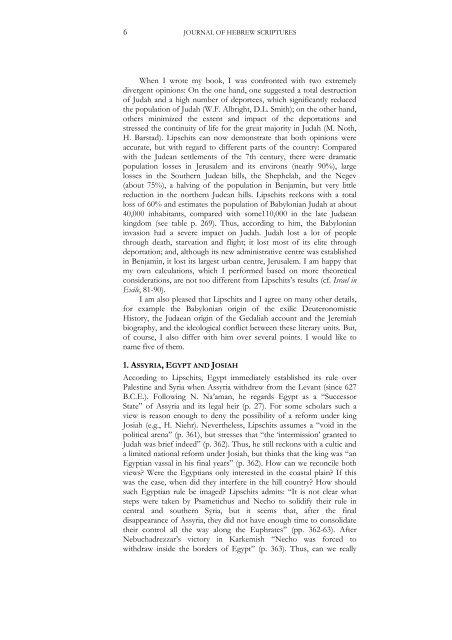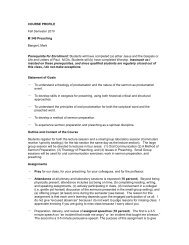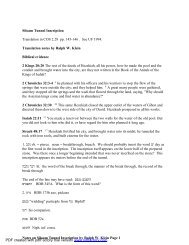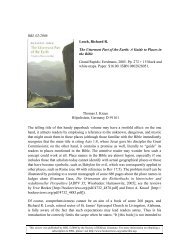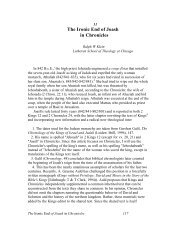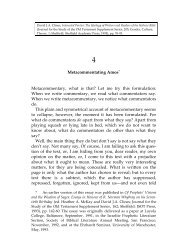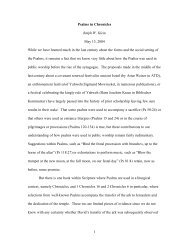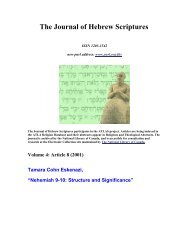Download this PDF file - University of Alberta - Journal Hosting
Download this PDF file - University of Alberta - Journal Hosting
Download this PDF file - University of Alberta - Journal Hosting
Create successful ePaper yourself
Turn your PDF publications into a flip-book with our unique Google optimized e-Paper software.
6JOURNAL OF HEBREW SCRIPTURESWhen I wrote my book, I was confronted with two extremelydivergent opinions: On the one hand, one suggested a total destruction<strong>of</strong> Judah and a high number <strong>of</strong> deportees, which significantly reducedthe population <strong>of</strong> Judah (W.F. Albright, D.L. Smith); on the other hand,others minimized the extent and impact <strong>of</strong> the deportations andstressed the continuity <strong>of</strong> life for the great majority in Judah (M. Noth,H. Barstad). Lipschits can now demonstrate that both opinions wereaccurate, but with regard to different parts <strong>of</strong> the country: Comparedwith the Judean settlements <strong>of</strong> the 7th century, there were dramaticpopulation losses in Jerusalem and its environs (nearly 90%), largelosses in the Southern Judean hills, the Shephelah, and the Negev(about 75%), a halving <strong>of</strong> the population in Benjamin, but very littlereduction in the northern Judean hills. Lipschits reckons with a totalloss <strong>of</strong> 60% and estimates the population <strong>of</strong> Babylonian Judah at about40,000 inhabitants, compared with some110,000 in the late Judaeankingdom (see table p. 269). Thus, according to him, the Babylonianinvasion had a severe impact on Judah. Judah lost a lot <strong>of</strong> peoplethrough death, starvation and flight; it lost most <strong>of</strong> its elite throughdeportation; and, although its new administrative centre was establishedin Benjamin, it lost its largest urban centre, Jerusalem. I am happy thatmy own calculations, which I performed based on more theoreticalconsiderations, are not too different from Lipschits’s results (cf. Israel inExile, 81-90).I am also pleased that Lipschits and I agree on many other details,for example the Babylonian origin <strong>of</strong> the exilic DeuteronomisticHistory, the Judaean origin <strong>of</strong> the Gedaliah account and the Jeremiahbiography, and the ideological conflict between these literary units. But,<strong>of</strong> course, I also differ with him over several points. I would like toname five <strong>of</strong> them.1. ASSYRIA, EGYPT AND JOSIAHAccording to Lipschits, Egypt immediately established its rule overPalestine and Syria when Assyria withdrew from the Levant (since 627B.C.E.). Following N. Na’aman, he regards Egypt as a “SuccessorState” <strong>of</strong> Assyria and its legal heir (p. 27). For some scholars such aview is reason enough to deny the possibility <strong>of</strong> a reform under kingJosiah (e.g., H. Niehr). Nevertheless, Lipschits assumes a “void in thepolitical arena” (p. 361), but stresses that “the ‘intermission’ granted toJudah was brief indeed” (p. 362). Thus, he still reckons with a cultic anda limited national reform under Josiah, but thinks that the king was “anEgyptian vassal in his final years” (p. 362). How can we reconcile bothviews? Were the Egyptians only interested in the coastal plain? If <strong>this</strong>was the case, when did they interfere in the hill country? How shouldsuch Egyptian rule be imaged? Lipschits admits: “It is not clear whatsteps were taken by Psametichus and Necho to solidify their rule incentral and southern Syria, but it seems that, after the finaldisappearance <strong>of</strong> Assyria, they did not have enough time to consolidatetheir control all the way along the Euphrates” (pp. 362-63). AfterNebuchadrezzar’s victory in Karkemish “Necho was forced towithdraw inside the borders <strong>of</strong> Egypt” (p. 363). Thus, can we really


